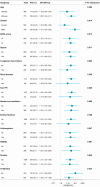Prophylactic proton pump inhibitor usage and new-onset acute kidney injury in critically ill patients: a retrospective analysis
- PMID: 40130229
- PMCID: PMC11932333
- DOI: 10.1093/ckj/sfaf037
Prophylactic proton pump inhibitor usage and new-onset acute kidney injury in critically ill patients: a retrospective analysis
Abstract
Background: Proton pump inhibitors (PPIs) are widely prescribed for stress ulcer prophylaxis (SUP) in intensive care unit (ICU) patients. However, the potential association between prophylactic PPIs and the development of new-onset acute kidney injury (AKI) remains unclear.
Methods: Patients without AKI or end-stage renal disease and not undergoing renal replacement therapy upon admission to the ICU were identified from the Medical Information Mart for Intensive Care (MIMIC-IV) database. The exposure factor for the study was the initiation of prophylactic PPIs within 48 h of admission, with the primary outcome being the occurrence of new-onset AKI after 48 h. Multivariable regression models were employed to investigate the association between prophylactic PPIs and the risk of new-onset AKI. Various propensity score analyses, along with stratified and subgroup analyses and E-value calculations, were conducted to further evaluate the reliability of the results.
Results: A total of 7498 ICU patients were analyzed. The multivariable analysis showed a higher incidence of new-onset AKI in the PPI group (30.7%) compared with the control group (24.1%), yielding an adjusted odds ratio (OR) of 1.43 (95% confidence interval 1.22-1.67). Propensity score analyses confirmed these results, with ORs ranging from 1.34 to 1.49 (P ≤ .005). Results from multiple sensitivity analyses further supported these findings, with an E-value of 2.34 indicating robustness against unmeasured confounders.
Conclusions: Prophylactic PPI use is associated with an increased risk of new-onset AKI in ICU patients. Indiscriminate use of PPIs should be avoided.
Keywords: acute kidney injury (AKI); intensive care unit (ICU); proton pump inhibitors (PPIs); stress ulcer prophylaxis (SUP).
© The Author(s) 2025. Published by Oxford University Press on behalf of the ERA.
Conflict of interest statement
The authors declare that they have no competing interests.
Figures
Similar articles
-
Effect of proton pump inhibitors versus histamine-2 receptor antagonists on acute kidney injury in septic patients at high risk for developing stress ulcers.Pharmacotherapy. 2024 Jul;44(7):539-548. doi: 10.1002/phar.2947. Epub 2024 Jun 20. Pharmacotherapy. 2024. PMID: 38899757
-
Proton Pump Inhibitors and Risk of Acute and Chronic Kidney Disease: A Retrospective Cohort Study.Pharmacotherapy. 2019 Apr;39(4):443-453. doi: 10.1002/phar.2235. Epub 2019 Mar 21. Pharmacotherapy. 2019. PMID: 30779194 Free PMC article.
-
Use of proton pump inhibitors and macrolide antibiotics and risk of acute kidney injury: a self-controlled case series study.BMC Nephrol. 2022 Nov 30;23(1):383. doi: 10.1186/s12882-022-03008-x. BMC Nephrol. 2022. PMID: 36451129 Free PMC article.
-
Association of Proton Pump Inhibitor Use and Immune Checkpoint Inhibitor-Mediated Acute Kidney Injury: A Meta-Analysis and a Review of Related Outcomes.Am J Nephrol. 2024;55(4):439-449. doi: 10.1159/000538274. Epub 2024 Mar 12. Am J Nephrol. 2024. PMID: 38471492 Free PMC article.
-
Re-evaluating the Utility of Stress Ulcer Prophylaxis in the Critically Ill Patient: A Clinical Scenario-Based Meta-Analysis.Pharmacotherapy. 2019 Mar;39(3):408-420. doi: 10.1002/phar.2172. Epub 2018 Sep 6. Pharmacotherapy. 2019. PMID: 30101529
References
LinkOut - more resources
Full Text Sources




